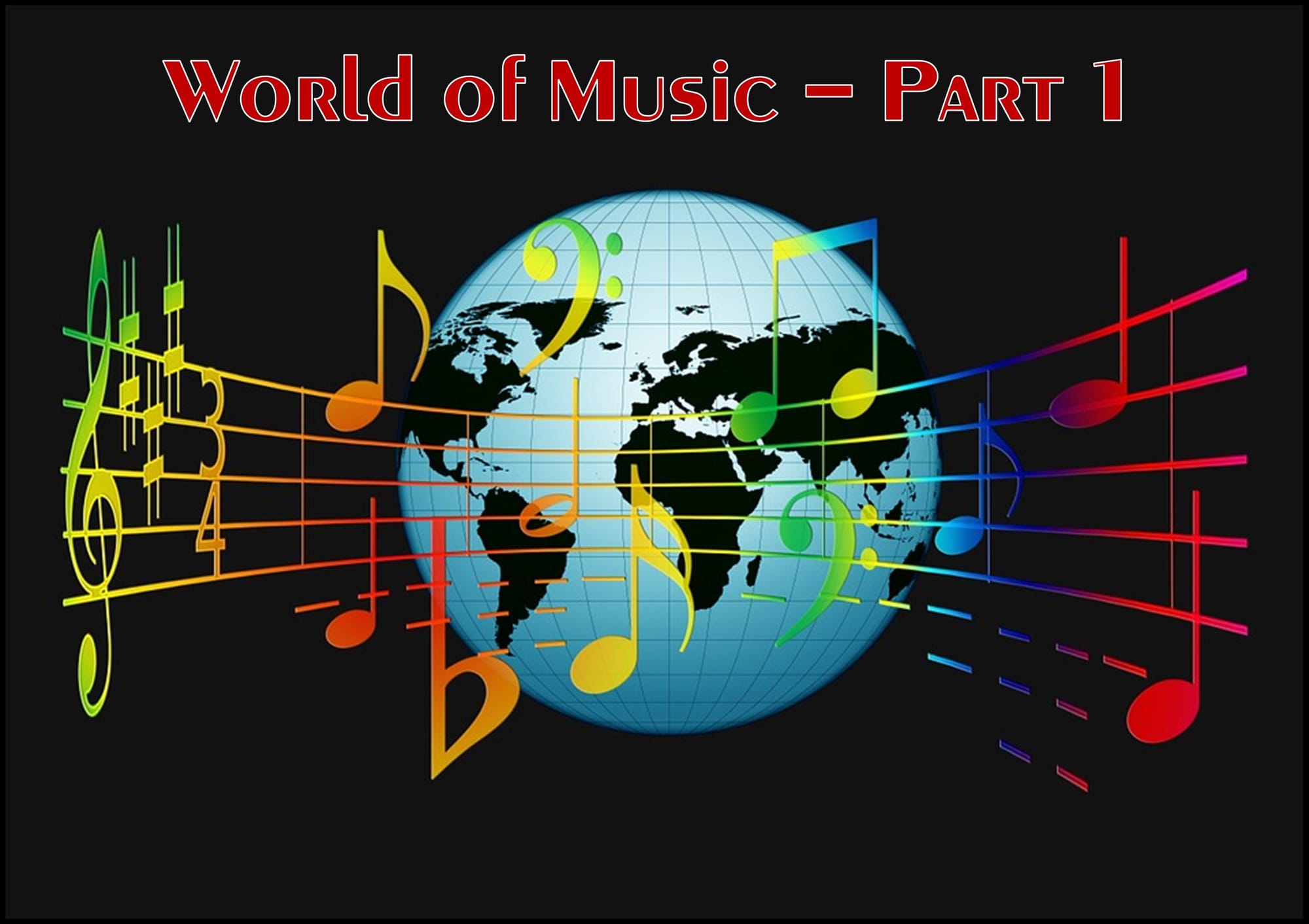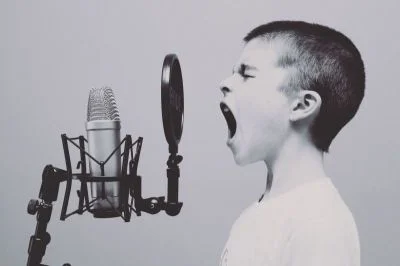The World of Music – Part One - A Comprehensive Overview

Introductory Note – This pair of articles was originally a live presentation called a Musician’s Clinic that was done at high schools near to where I would be doing a concert that evening. It not only encouraged the students to come out to hear me, but, more importantly, it gave them a much broader view of what being involved in music could be like, whether as a profession or for enjoyment. These articles will cover the myriad of music related vocation possibilities that were first presented in the Musician’s Clinics.
In Part One, we’ll look at:
- General Considerations – Just some things that all musicians have in common.
- Specific Helps – Some detailed things for different kinds of musicians, focusing on:
- How to Make Art, not just Music
- Tips for Music Writers / Composers
- Rehearsal techniques that will work with a garage band or a full orchestra

GENERAL CONSIDERATIONS – There are a number of things that a musician of any sort needs to have and to do to be able to enjoy music and to have the sense of accomplishment and satisfaction that comes with a job done well.
1. Know where you’re going. Just saying, “I want to do music” is a very vague goal. It’s very important to have your own Philosophy of Music. Decide, or discover, what you believe music to be to you. It can be a number of things, separately or in combination with each other. Write it out clearly so you can fine-tune it if needed. In it, include whatever guidelines you may want to set for yourself. Personal Note – In my Philosophy of Music, I said that I would not play certain types of instruments or allow them in my recordings – things like synthesized drums or imitation horns.
The following are three general categories of music philosophy. You may have another; don’t be afraid to apply it.
* Pure Expression You can let what is in your heart, mind and/or emotions simply flow through your music. This sounds very “artistic”. However, you may not be communicating.
* Communication This is also expressing yourself, but it’s done in a way so that other people will know what you mean. This requires much more skill and reaches a larger audience.
* Mercenary music. This involves writing, playing, etc. purely because you’re being paid. So-called “hired guns” fall into this category. People who write for movies and TV must write for the scene. It’s difficult, but can be very rewarding. This type of outlook maybe should be combined with some personal expression to ensure a balanced musician.
2. Be willing to improve your skills. Be teachable. NO ONE knows everything about music. Bach and Beethoven were still learning until the end of their lives.
- Lyric writers should take writing classes, read books on writing styles, listen very carefully to ALL types of music and lyric styles, study poetry and above all, WRITE a LOT. This may not be what a writer wants to hear, but, at least some of the things you write won’t be very good. A good thing to do is to write to the best of your ability, then put it away for a week or two. Then, read it or sing it again and see if it’s worth using the way it is. If not, make some edits, huge ones if needed.
- Music writers and arrangers should find ALL SORTS of music styles to study, going back at least as far as the Baroque period. Remember, all the little titles that are currently in use to describe Rock and Country music, like hard rock, soft rock, death metal, etc. will be rolled into one category by future music analysts. Study Schoenberg’s tone rows and Mozart’s variations on Twinkle, Twinkle, Little Star. Arrangers should work on presenting a piece in a number of different ways, from very simple to very complex. Different audiences like their music different ways. And above all, WRITE a LOT.

- Singers, DO NOT try to be someone else. Everyone has a unique quality that needs to be heard. If you try to be like your favorite singer, one of you is unnecessary. And since your favorite singer is well known already, the unneeded one will probably be you! Take lessons, even if you already have a great voice. Very often, there are things to know to keep that voice healthy for the rest of your life. It can be damaged or lost if it’s mistreated. You may even improve your range and projection.
- Instrumentalists, PRACTICE. Practice may not make perfect, but it will get you a whole lot closer than you were. Sometimes a person can think that since he or she knows how to play an instrument that that’s all there is. Take a few refresher lessons if you tend to get stale in your style. Study and play as many different types of music as you can play on your instrument. That way, you’ll have a wide background to draw from, especially if you’re improvising.
Personal Note – I played trumpet in middle and high school and in college. As I progressed through each year, my skill level was expected to improve, and I rose to meet that challenge. However, once I was out of school, the only place I could play my horn was in church. And, while I loved being able to serve the Lord that way, it wasn’t very challenging. So, when I was invited to join a polka band, I jumped at the chance to challenge my chops. No, it wasn’t me favorite type of music, but it was fun and my playing skills improved so that I could do more with the music at church as well. - People in other musical fields need to be learning and practicing as well. If you want to be a booking agent, find some interesting places for your high school concert band, choral group or string orchestra to play (with the director’s permission, of course), or find places for your favorite garage band to play. You probably won’t get paid, but you’ll learn how to deal with people and be convincing about the “product” you’re selling. If you want to conduct, take lessons and volunteer to lead whatever group will let you. If you want to record, find a recorder of some kind, a mic or two and start recording. See how the sounds go together. Get better gear as you go. Don't wait for the $30,000 to get started "Right”.

Another Personal Note – My first “multi-track recording” was actually a series of ping-pong recordings done with two reel-to-reel tape recorders. The process goes like this:
A. Record the first track on one machine, whether a solo instrument or voice or a group. The important thing is that once that track is down, and you add the second track, there’s no going back to fix the first, so be sure that it’s the way you want it to sound.
B. Feed the first track through a mixer, add the second track and record it on a second recorder. You may have to do this a few times to get the balance right, but you’ll have to play it perfectly each time.
C. Feed this new track set back through the mixer (you may have to keep switching wires) and add the third track.
D. If you want an effect for an instrument or voice, (e.g., a tremolo for a guitar), you need to insert that when you add that instrument to the mix.
E. Repeat until you have all the tracks. It will sound best if you add the voice(s) last.
There’s a YouTube video of the recording. It’s called Jewels and Treasures and was written as a project for a music theory class.
SPECIFIC HELPS
For ALL Musicians – Make it Art, not just music. There is a difference between a piece of music being just music and it being real art. There are a bazillion people who can create music. The simple definition of music is “organized sound”. Most pop music of any genre is not art. It’s enjoyable and popular, but it’s not art; it’s a craft. All good art contains two fundamental qualities – Beauty and Power. There are numerous in-depth analyses of art, but, in the end, it boils down to Beauty and Power. This is accomplished by using two more essentials – Tension and Release (ups and downs, tight and relaxed, light and dark, etc.) For a more in-depth study, see my article entitled What is Music, Is It Art.
Now, for particular types of musicians – Music Writers / Composers of any sort:
1. Use an easily identifiable FORM, so it’s easy for the listener to “digest”. There is a place for artistic free-form or unstructured music, but that would be for a very intellectual audience. For most people you need to follow these examples:
a) Verse – chorus (called strophic or AB form)
b) ABA or Sonata Allegro (Exposition, development, recapitulation. Straight, heavily modified (key, embellishments, meter), once again with the highlights of development)
c) Rondo (ABACABA-coda / chorus, verse 1, chorus, verse 2, chorus, verse 1, chorus, ending)
2. Use conjunct (smooth) and disjunct (“choppy”) MELODY for contrast, to accentuate the lyrics, if any, or mood of the piece.
a) The melody can be DEPENDENT or INDEPENDENT of the chords. You can create tension when the notes are independent of the chord and release when they are part of the chord.
b) Start the melody off-tonic, out-of-chord
c) Start the song off-tonic. Use a dominant or super-tonic chord to start.
3. Pick an appropriate KEY.
a) Choose from MAJOR, MINOR, MODAL or a combination. Major and minor are fairly well known. Modal has no sharps or flats, but depends on where the scale starts on the white keys of a piano to determine its sound.
b) Choose a range that fits the mood of the song as well as the abilities of the players and singers.
4. Use an interesting CHORD PROGRESSION or set of progressions.
a) Decide if the progressions will be the same for verse and chorus or through-composed.
b) Will there be a key change? Will it be progressive (sneaky) or drastic?
c) Chord progression examples (Nashville Numbers and Chord Examples in the key of C):
1-4-5-1 _____ C-F-G-C
1-6-4-5 _____ C-Am-F-G
1-6-2-5 _____ C-Am-Dm-G
1-7b-4-1 _____ C-Bb-F-C
1-7b-6b-5 _____ C-Bb-Ab-G
12 bar with variations C-C-C-C7-F-F-C-C-G-F-C-G
5. Use a “HOOK”, a melodic or lyric device that “grabs” the listener’s ear as if to say, “You will listen”. These are the most effective if both of them are good. For pop music of any genre, it seems that a good lyrical hook is more in demand; the music can suffer a bit. For more serious, or classical, music, the musical hook must be very good, if not great.
6. Maintain the “BIG PICTURE” for the song. Don’t get wrapped up in style and technique that you lose sight of what the whole song is supposed to be doing.
For example, if you’re writing a rock song and you’ve settles on a chord progression and assigned each chord to so many beats, and you start fitting the lyrics and tweaking them to fit your structure, but they don’t seem to fit well. Remember that it’s still a rock song. Lengthen or shorten the musical phrases. A little extra space between words can really be good; sometimes less is more.
7. For pop writers, if you’re going to be giving this to other players - rhythm, horns, back-up singers, etc., try to keep in mind how easily your song can be arranged. Don’t make it an impossible piece for the sax player.
For serious music composers, if you’re writing for a string orchestra, it may be that the best sound for the piece is that of the strings. But, keep in mind that many good musical works can be arranged for other groups such as woodwind or brass ensembles, concert bands, etc.

Rehearsal Techniques – Good for All Musicians
* The leader / conductor should have a real good idea of how the piece should sound. If the group leans more on improvisation there still should be an overall impression to shoot for.
* Play the piece all the way through once, unless a major train wreck happens. If so, then start with the bracketing technique described below.
* Bracketing is used to iron out rough spots
1. First, isolate the rough spot.
2. Play it through until it’s played correctly three times. Less than that could be an accident.
3. It may be necessary to break this section into smaller bits (smaller groups of instruments) to determine where the problem really is.
4. You may need to play it slower than normal to hear where something is going wrong.
5. If you’ve got distortion on an electric guitar or mutes in the trumpets, you may need to play it “clean” to catch the mistake.
6. Once you’ve played it three times correctly, play the spot starting a measure or two before and continuing a measure or two after. Do this until you’ve done it three times correctly.
7. Then play it again, starting at the beginning of the section (verse, chorus etc.) and continuing to the end. Repeat three times correctly.
8. Then, do the whole song three times correctly. If you’ve got more than one rough spot, smooth them out one at a time in each section, then put the whole song together.
* A good general rule for practice is this: It takes 40 hours of rehearsal for each hour of play time in concert.
Be sure to read Part Two in this series.
Salt Cellar Creations understands the beauty and power that music of all kinds can convey and has a growing library of original works and arrangements for Concert Bands, Choral Groups, String Orchestras, Soloists and Small Groups. There is also a growing catalog of original concert works by John Daniels (the Heart of Salt Cellar Creations) from his touring days. Find out more about all that Salt Cellar Creations has to offer HERE.
SCC can also compose an original piece for you or do a custom arrangement for you. There are two ways that this can be done; one is much more affordable than the other. And SCC is always looking for ideas of pieces to arrange or suggestions for original pieces.
We have sold music not only in the US but in Canada, the United Kingdom, France, Australia, New Zealand, Austria, and Germany. Please visit the WEBSITE or CONTACT US to let us know what we can do for you!